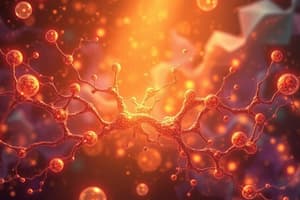Podcast
Questions and Answers
The conversion of tryptophan to 5-hydroxytryptophan is not considered a rate limiting step in the overall metabolic process.
The conversion of tryptophan to 5-hydroxytryptophan is not considered a rate limiting step in the overall metabolic process.
False (B)
5-hydroxyindoleacetic acid (5-HIAA) is a product of the oxidative deamination of tryptophan.
5-hydroxyindoleacetic acid (5-HIAA) is a product of the oxidative deamination of tryptophan.
True (A)
5-hydroxytryptophan is synthesized from tryptophan using the enzyme tryptophan decarboxylase.
5-hydroxytryptophan is synthesized from tryptophan using the enzyme tryptophan decarboxylase.
False (B)
5-hydroxytryptamine (5-HT) is produced from 5-hydroxytryptophan through a non-specific hydroxylation reaction.
5-hydroxytryptamine (5-HT) is produced from 5-hydroxytryptophan through a non-specific hydroxylation reaction.
In the degradation of tryptophan, monoamine oxidase-B is more active than monoamine oxidase-A.
In the degradation of tryptophan, monoamine oxidase-B is more active than monoamine oxidase-A.
Flashcards
Tryptophan to 5-Hydroxytryptophan Conversion
Tryptophan to 5-Hydroxytryptophan Conversion
The conversion of tryptophan to 5-hydroxytryptophan is the first and most important step in the synthesis of serotonin.
Tryptophan Degradation
Tryptophan Degradation
Tryptophan is broken down by monoamine oxidase (MAO), mainly MAO-A, to produce 5-HIAA, which is excreted in urine.
What is serotonin?
What is serotonin?
A neurotransmitter derived from tryptophan that plays a role in mood, sleep, and appetite.
What is biosynthesis?
What is biosynthesis?
Signup and view all the flashcards
What is degradation?
What is degradation?
Signup and view all the flashcards





